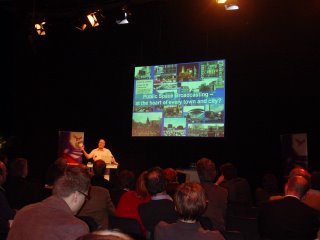 Mike Gibbons of BBC Big Screens presented an interesting case about the use of big screens by the BBC in five UK cities. In those cities the BBC co-operates with the city council, a hardware provider (in this case Philips) and local cultural institutions (arts and movies). The big screens are on 24 hours 7 days and have a mix of local news, broadcasts of local movie makers and BBC news. But of course the screen is at its best at events and disasters, such as rugby games, the Queen’s jubilee and the London bombings. BBC has now experience for one year. They have learned that money is not enough, but screens should be in the proper place where people can sit on stairs and where there is no traffic). The BBC screens do not make money and have no advertisements. Now the BBC unit is moving on to use generated content (showing SMS, playing mobile games, voting, taking virtual goals with intelligent camers mounted in the borders of the screen). Mike made two interesting remarks: screen can contribute to the economic revival of the particular area (e.g. in Liverpool); it is remarkable that in a time where everyone has his mobile and his iPod, people love to get involved in large events such as soccer or rugby games around screens.
Mike Gibbons of BBC Big Screens presented an interesting case about the use of big screens by the BBC in five UK cities. In those cities the BBC co-operates with the city council, a hardware provider (in this case Philips) and local cultural institutions (arts and movies). The big screens are on 24 hours 7 days and have a mix of local news, broadcasts of local movie makers and BBC news. But of course the screen is at its best at events and disasters, such as rugby games, the Queen’s jubilee and the London bombings. BBC has now experience for one year. They have learned that money is not enough, but screens should be in the proper place where people can sit on stairs and where there is no traffic). The BBC screens do not make money and have no advertisements. Now the BBC unit is moving on to use generated content (showing SMS, playing mobile games, voting, taking virtual goals with intelligent camers mounted in the borders of the screen). Mike made two interesting remarks: screen can contribute to the economic revival of the particular area (e.g. in Liverpool); it is remarkable that in a time where everyone has his mobile and his iPod, people love to get involved in large events such as soccer or rugby games around screens.The next speaker, of Ledvertisement, made a mess of his speech. The only thing he attempted to get across was that people did not want to be confronted with advertisements on a big screen in a public space. A colleague who took over, gave more sensible information. The company is hoping to have 10 big screens installed this year in the Netherlands. Presently they operate big screens in the center of the cities of Eindhoven, Groningen and one near the Arena, the Ajax soccer stadium. Getting a screen in a particular place takes a long time as you have to have the format ready before the license is issued. Ledvertisement indicated that local information was important. In Eindhoven for example they get a feed from PSV TV, the television station of the local soccer team. Ledvertisement has a fixed schedule, so that people know when the advertisements start to pass by. There is no sound with the broadcast, contrary to the BBC’s big screens, where they use an environment sensitive audio system. It is unbeleivable that you slip back into the times of the silent movies, while you have all the ambient opportunities around.
Are these two examples of big screens instances of narrow casting? To me big screens in public places are just a variation on broadcasting in particular places.
Coming back from the Crossmedia Café I landed in the midst of virtual sports shots at Utrecht station. At the occasion of the Olympic Winter Games, the Dutch railway company NS has remodelled part of this station into Piazza Torino. Travellers can have a short movie shot where they skate virtually in the Dutch speed skating temple Thialf in Heereveen. The virtual skater receives his/her movie through internet. Travellers can also have a photograph taken with their favourite virtual champion speed skaters. The idea and realisation are executed by @Hand Communications.
Tags: narrow-casting, big screens

No comments:
Post a Comment